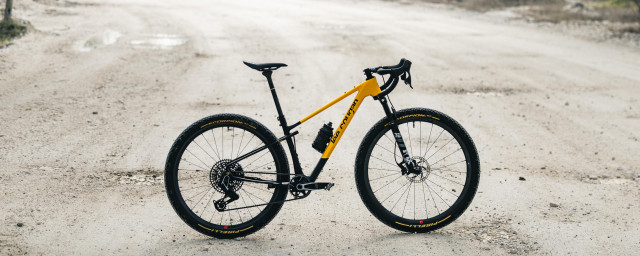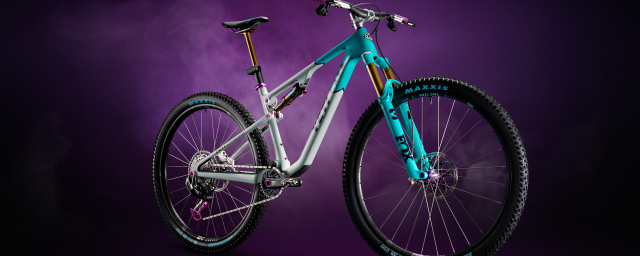Merida Silex 10k first ride review

The gravel space has quickly grown and continues to evolve on what feels like an annual basis. Bikes are getting more capable and can traverse terrain once reserved exclusively for mountain bikes. Merida’s Silex is a case in point. Developed to combine the best attributes of both the mountain bike and road bike, the name of the game has always been versatility – and the new Silex delivers this on many levels. We were invited to Scandiano in Italy’s Reggio Emilia province to test the bike for ourselves and establish if the changes to its geometry have positively influenced its capabilities on all terrain types.
- Best gravel bikes under £1,500 in 2023 - drop-bar machines that won't break the bank
- Gravel bike vs mountain bike: what are the differences?
- Gravel bike racing – everything you need to know
Merida Silex 10k - Design and aesthetics
The first-generation Silex polarised opinion and was criticised for its somewhat oddball looks – particularly the elongated headtube. The new model has successfully addressed the visual shortcomings of its forebear and the result is an attractive gravel bike that fits in well with Merida’s current bike portfolio.
There’s a raft of colour options available across the model range, including the ‘space teal’ of the Merida Silex 10k bike pictured here. The iridescent hue does a great job of accentuating the contours of the new Silex, which explodes in granularity when touched by the sun. The design is very clean with less cable faff evident throughout the bike and on the front end, the latter opening up the ability to fit a bar bag. Much of the hose-free look comes from the Wire Port integrated cable routing as seen on the Scultura and Scultura Endurance road bikes. The frame is compatible with internally routed dropper seatposts and also utilises a top-tube-integrated seatpost clamp and Fidlock base mount (the latter on CF models only) for a cleaner aesthetic.
Merida was clear to point out it merely altered the Silex rather than completely overhauling the design blueprint. As a result, the new model retains much of its forebear's frame architecture with the most notable changes coming in the form of the aggressively dropped chainstays (introduced to play nicely with 1x and 2x chainset configurations), the shortened headtube and longer fork, and the increased tyre clearance that is now rated at a maximum of 45mm (42mm with fenders). This also means the riding position is almost identical to the Silex generation one but I’ll touch on the geometry numbers a little later.
Unlike Merida’s road bike range, there’s only one carbon-fibre layup available across all four models. A medium frameset tips the scales at 1,220g, 680g lighter than the alloy version (both the CF and alloy bike utilise a 540g carbon fork). A full bike in medium weighs just over 9kg without pedals, which is impressive given the bike’s rowdy nature and bigger tyres. While the Silex is adept at gravel racing and all-road excursions, the company has not marginalised those who enjoy adventure riding and bike packing and, as a result, has liberally appointed with bike with a compendium of mounting point options. Carbon-fibre frames can fit mudguards, extra storage and panniers thanks to bosses located on the frame and fork. Aluminium frames get all that plus the ability to install a rear carrier rack.
Merida Silex 10k - Technical details and build
The range spans seven distinct models: four carbon fibre and three alloy bikes. The carbon models include the Silex 10k, 8000, 7000 and 4000 while the alloy Silex comes in 700, 400 and 200 derivatives. There’s a lot to offer – both in terms of price points and spec levels. Our test bike was the range-topping Merida Silex 10K complete with carbon-fibre frame and mix of SRAM’s Red AXS and X01 componentry set up in a mullet configuration. This means a 42T front chainring that drives a 10-52T Eagle X01 cassette via 170mm cranks – it also gets a Quarq power meter. The shifters and brakes are SRAM Red AXS, which clamp onto Centerline X 180mm rotors front and rear.
In terms of geometry, a lot has changed – the most notable of which is the head angle that has been slackened by 1.5-degrees to 69.5-degrees.The sizing convention is also a little different to the industry standard but there are still five sizes available: XS, S, M. L and XL. While my test bike was an XS, the top tube measured 55cm, which gives you an idea of how Merida has structured things. I usually ride a 54cm given my 175cm height but the short 80mm stem meant the measurements were spot on for me, with no notable toe overlap. Reach and stack are rated at 392mm and 570mm respectively while the chainstays and wheelbase come in at figures of 430mm and 1,048mm.
Looking at the balance of the build, the Silex 10k rolls on Reynolds Black Lable G700 Pro wheels shod with Maxxis Rambler 45c rubber. The handlebar is a 40cm Easton EC70 AX unit which is held in place by an alloy Merida Team CC III stem. Other bits include a gravel-specific Prologo Scratch M5 AGX saddle and RockShox Reverb XPLR AXS dropper post.
Merida Silex 10k - Performance
The selection of courses mapped out for us by Merida was designed to showcase the Silex’s technical proficiency as much as its turn of speed on open gravel roads and smooth asphalt. Despite the 69.5-degree head angle and wheelbase, it’s an impressively agile and eager machine – able to accelerate and maintain momentum with ease.
The product engineers were eager to push the news of Matej Mohoric’s victory aboard the new Merida Silex, citing its ‘all-rounder’ character as the secret to its success at the UCI Gravel World Championships 2023 and, I must admit, I agree with that sentiment. Many contemporary gravel bikes are either too racy or too capable – both of which come with several trade-offs but the Silex does a bloody good job of blending these two extremes and it was clearly evident on the trails we negotiated.
The moment we left the Tarmac, the new Merida Silex came into its own. While it's perfectly adept on paved surfaces, the bike was chiefly designed to venture off-road – soaking up imperfections, choppy corrugated grasslands and rocky terrain with relative ease. The slackened head angle means control is maximised during tight switchbacks - both up and down - and the shorter stack, longer fork and 45mm tyre footprint equip it with all it needs to dismiss technical single track and descents with confidence.
Despite the somewhat relaxed geometry, it’s still pretty good at climbing, too, granted you’ll need to use momentum to ensure you keep your speed entering an incline. Slower terrain is more of an effort as it doesn’t feel as lively as some of its racier rivals but it makes up for this on the descents and flats. In fact, the Silex is so capable that we hurtled down rock-strewn, technical singletrack I'd usually only ride on a cross-country mountain bike.
An interesting addition and something that no doubt helped instil in the rider a heightened level of confidence are the 180mm rotors fitted front/rear. While Merida claims this move was included to cater for the added weight of luggage and bike bags, it’s had a positive effect on its technical proficiency, too. Throw in the dropper post and you’re all set to tackle a challenging day out. While none of the Silex models come standard with front suspension, aftermarket forks such as the RockShox Rudy are comparable and won’t negatively impact the geometry and front end. From what we sampled, coupled with the larger volume tyres and subsequent lower pressures, there’s really no need to go the suspension fork route unless your home trails comprise extremely challenging and rocky sections.
Merida Silex 10k - Early verdict
Merida has done a great job with the new Silex. Not only is it more attractive than before but it also possesses an abundance of endearing qualities that cater for the entire gravel demographic – an impressive feat in itself. Where its rivals either have a racy or rowdy bias, the Merida has managed to meld both these qualities and the result is one of the best all-round gravel bikes on the market. Having pushed the bike to its absolute limits, both on the climbs and gnarly descents, I’ve been struggling to find something negative to mention – perhaps it's the Fidlock base and stock tyre choice but that’s a personal grievance if anything, I prefer a traditional cage and the tyres can easily be swapped out.
In terms of what the new Merida Silex offers; not only does it have the attributes to compete against the segment’s incumbents – winning the UCI Gravel World Championships 2023 is a case in point – it’s also geared to take a more recreational/adventurous approach thanks to its number of mounting points, huge brake rotors and slackened head tube angle. Those who want to get rowdier can always just fit a suspension fork or ditch the dropper post for a lighter and more responsive machine – there are myriad ways to set it up.
Looking at its chief adversaries, the Silex goes up against a mixed bag of bikes and that’s based purely on the breadth of its skill set. In this case, the YT Szepter, Canyon Grail, Cervelo Aspero and Specialized Diverge STR. While the latter three have more brand punch than Merida and the YT Szepter is naturally more gravity-focused, the Silex presents an intriguing case based on the fact it can hold its own against all four and more. This and its subsequent pricing to suit all budgets should place it at the top of any gravel rider’s new bike shopping list.
Merida Silex 10k - Model range and pricing
| Merida Silex 200 | £1,275 | € 1,500 |
| Merida Silex 400 | £1,650 | € 1,980 |
| Merida Silex 700 | £2,350 | € 2,820 |
| Merida Silex 4000 | £2,250 | € 2,700 |
| Merida Silex 7000 | £3,000 | € 3,600 |
| Merida Silex 8000 | £5,250 | € 6,300 |
| Merida Silex 10K | £8,750 | € 10,500 |

















